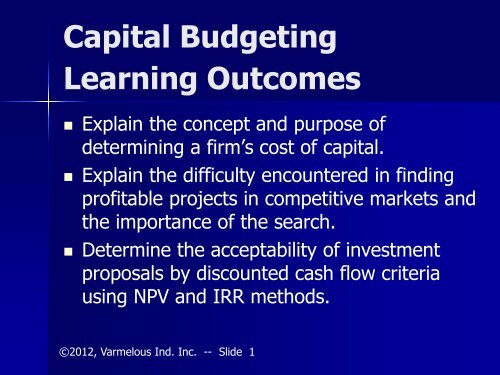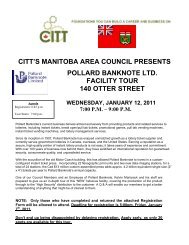CapitalBudgeting_201.. - CITT
CapitalBudgeting_201.. - CITT
CapitalBudgeting_201.. - CITT
Create successful ePaper yourself
Turn your PDF publications into a flip-book with our unique Google optimized e-Paper software.
Capital Budgeting<br />
Learning Outcomes<br />
• Explain the concept and purpose of<br />
determining a firm’s cost of capital.<br />
• Explain the difficulty encountered in finding<br />
profitable projects in competitive markets and<br />
the importance of the search.<br />
• Determine the acceptability of investment<br />
proposals by discounted cash flow criteria<br />
using NPV and IRR methods.<br />
©2012, Varmelous Ind. Inc. -- Slide 1
The Concept of the Cost<br />
of Capital<br />
• In capital budgeting there are two<br />
major aspects to be considered:<br />
– The investment decision, and<br />
– The financing decision.<br />
©2012, Varmelous Ind. Inc. -- Slide 2
The Concept of the Cost<br />
of Capital<br />
• The investment decision is the decision to<br />
acquire an asset, a project, or product line,<br />
i.e., to buy, to lease, or not to lease.<br />
– It is partly derived from the management decision<br />
that requires a minimum rate of return<br />
expectation from such an investment. This rate is<br />
called by various names: hurdle rate, cost of<br />
capital, cut-off-rate, discount rate, or required rate<br />
of return (RRR).<br />
©2012, Varmelous Ind. Inc. -- Slide 3
The Concept of the Cost<br />
of Capital<br />
• The financing decision<br />
• The financing decision is a method of raising<br />
capital to make the investment decision, i.e., by<br />
creating debt, i.e. debentures, bank loans, leases,<br />
or by sale of equity, or both.<br />
©2012, Varmelous Ind. Inc. -- Slide 4
The Concept of the Cost<br />
of Capital<br />
• To summarize, the cost of capital is the rate<br />
of return on the firm’s total investments<br />
which earns the average rate of return<br />
needed to satisfy all the sources of longterm<br />
financing:<br />
• Therefore…<br />
©2012, Varmelous Ind. Inc. -- Slide 5
The Concept of the Cost<br />
of Capital<br />
• when the firm's rate of return is the<br />
same as its cost of capital on an<br />
investment project, the price of its<br />
common shares normally remain<br />
unchanged following the acceptance<br />
and implementation of the project,<br />
• and…<br />
©2012, Varmelous Ind. Inc. -- Slide 6
The Concept of the Cost<br />
of Capital<br />
• when the firm earns a greater rate of return than<br />
its cost of capital, the greater return will normally<br />
increase the value of the firm’s common shares and<br />
consequently, an increase in shareholder wealth.<br />
• Important to remember..<br />
– The minimum rate of return that an investment is<br />
expected to provide in order to justify its acquisition is<br />
known as the hurdle rate, cost of capital, cut-off-rate, or<br />
discount rate, or the required rate of return (RRR).<br />
©2012, Varmelous Ind. Inc. -- Slide 7
The Concept of the Cost<br />
of Capital<br />
• It is important to note that investment and<br />
financing decisions should be based on the<br />
investor’s marginal cost of capital. Management<br />
should avoid using subjective criterion when<br />
analyzing investment and financing proposals. The<br />
marginal cost of capital has been determined in the<br />
financial markets. This encourages management to<br />
impose market discipline on its decisions. Finally,<br />
this approach ensures that market or intrinsic value<br />
is added to shareholder wealth.<br />
©2012, Varmelous Ind. Inc. -- Slide 8
Difficulty and importance in<br />
finding profitable projects<br />
• Due to competition, it is difficult to find new project<br />
ideas that are profitable.<br />
• If a company develops a new and profitable<br />
product, it will not be long before other companies<br />
introduce a competitive product at a lower price in<br />
order to capture market share. Such competitive<br />
forces will result in lower profits and it may happen<br />
very quickly, especially if there isn't any barrier to<br />
entry into the market.<br />
©2012, Varmelous Ind. Inc. -- Slide 9
Difficulty and importance in<br />
finding profitable projects<br />
• For companies to remain competitive and survive,<br />
they must practice timely investments in new<br />
profitable projects.<br />
• Putting into practice a strategy of implementing<br />
such investments shall require the use of capital<br />
budgeting techniques.<br />
©2012, Varmelous Ind. Inc. -- Slide 10
Capital Budgeting<br />
• When evaluating a Proposed Capital Expenditure<br />
Net after-tax cash flows, and not accounting net<br />
income, are used to evaluate proposed capital<br />
expenditures.<br />
• Evaluation of a Proposed Capital Expenditure can<br />
be separated into two categories (methods), as<br />
follows:<br />
– Non-discounted cash flow techniques, and<br />
– Discounted cash flow (DCF) techniques<br />
©2012, Varmelous Ind. Inc. -- Slide 11
Capital Budgeting<br />
• The major difference between the two methods of<br />
evaluation is:<br />
– Discounted cash flows recognize the time-valueof-money.<br />
As you may be well aware, a dollar<br />
today is worth more than a dollar tomorrow and<br />
much more than one five years from now.<br />
©2012, Varmelous Ind. Inc. -- Slide 12
Capital Budgeting<br />
• Cash Flows:<br />
– The evaluation of a proposed capital project<br />
involves the use of net after-tax cash flows, (net<br />
meaning cash receipts less cash disbursements),<br />
rather than the concept of accounting net<br />
income. Cash in-flows are receipt of cash and<br />
cash out-flows are those transactions that<br />
require an expenditure of cash.<br />
©2012, Varmelous Ind. Inc. -- Slide 13
Capital Budgeting<br />
• Cash Flow examples:<br />
– The Examples of cash in-flows are new or additional sales and<br />
savings due to lower or eliminated product costs or expenses.<br />
– Examples of cash out-flows are additional purchases of materials,<br />
increased cost for labour or other overheads (indirect expenses),<br />
such as the incremental increase in: rent, utilities, taxes, and<br />
other similar expenses that require a cash disbursement, related<br />
to the project.<br />
• Some expenses do not require a cash out-flow and are not directly<br />
considered in the cash flow analysis. Examples of such expenses are<br />
any form of amortization (depreciation or depletion) of a capital<br />
asset.<br />
©2012, Varmelous Ind. Inc. -- Slide 14
Capital Budgeting<br />
• Discounted Cash Flow example:<br />
• The cash flows in the example presented are<br />
somewhat simplified. Some of the elements of the<br />
cash flow analysis, such as tax shields, which are<br />
the result of depreciation for tax purposes, known<br />
as Capital Cost Allowance, (commonly abbreviated<br />
as CCA) will be provided without supporting detail.<br />
The Finance department of your company would<br />
usually provide such details.<br />
©2012, Varmelous Ind. Inc. -- Slide 15
Discounted Cash Flow –<br />
Net Present Value (NPV)<br />
• Discounted cash flow techniques base the decisions<br />
on the investment’s cash flows after it is adjusted<br />
for the time value of money.<br />
• In this presentation we will ignore the problem of<br />
incorporating risk into capital budgeting decisions.<br />
Also, the appropriate required rate of return<br />
(R.R.R.) will be given.<br />
©2012, Varmelous Ind. Inc. -- Slide 16
Discounted Cash Flow –<br />
Net Present Value (NPV)<br />
• The two most frequently used discounted cash flow<br />
evaluators are:<br />
• Net Present Value (NPV) which measures discounted cash<br />
flows in versus discounted cash flows out, using the stipulated<br />
required rate of return, and<br />
• Internal Rate of Return (IRR) which is the rate of return at<br />
which the discounted cash flows in are equal to the<br />
discounted cash flows out, i.e., net present value is equal to<br />
zero.<br />
• Both of these methods have similar advantages and<br />
disadvantages.<br />
©2012, Varmelous Ind. Inc. -- Slide 17
Discounted Cash Flow –<br />
Net Present Value (NPV)<br />
• The main advantages are:<br />
• All net cash flows over the life of the project are considered in<br />
the evaluation, and<br />
• The time value of money is recognized, i.e., earlier cash flows<br />
are better (worth more) than are later cash flows.<br />
• The main disadvantages are:<br />
• Much detailed information must be identified and gathered,<br />
and<br />
• Calculations can be time consuming and complex.<br />
©2012, Varmelous Ind. Inc. -- Slide 18
Discounted Cash Flow –<br />
Net Present Value (NPV)<br />
• However, modern personal computers with<br />
spreadsheet software have negated much of the<br />
computational complexity and allow for almost<br />
instantaneous what-if scenarios for alternate<br />
consideration in the evaluation process.<br />
• The use of recent integral computing techniques<br />
contained in most spreadsheet programs like Excel,<br />
make the computation of both NPV and IRR<br />
relatively simple. Tools like Goal Seek will facilitate<br />
the computation of IRR once NPV has been<br />
calculated using the requisite data.<br />
©2012, Varmelous Ind. Inc. -- Slide 19
Discounted Cash Flow –<br />
Net Present Value (NPV)<br />
• The project’s NPV is the net value in today’s dollars<br />
of the cash in-flows and out-flows. The TVM factor<br />
is not violated because all of the cash flows are<br />
discounted back to the present. The deciding<br />
criteria are:<br />
• NPV => 0, accept project because the project’s return on<br />
investment (ROI) is equal to or greater than the firm’s<br />
required rate of return (RRR).<br />
• NPV < 0, reject project because the project’s ROI is less<br />
than the firm’s RRR.<br />
• NPV = 0, then the project is returning the firm’s RRR.<br />
©2012, Varmelous Ind. Inc. -- Slide 20
Discounted Cash Flow –<br />
Net Present Value (NPV)<br />
• The reason for the use of the Net Present<br />
Value (NPV) method is quite clear.<br />
– If a firm accepts a project with a positive NPV,<br />
the value of the firm will increase and thus<br />
so will the wealth of the current<br />
shareholders.<br />
– The inverse holds true, if there is a negative<br />
NPV the shareholder wealth will decrease.<br />
©2012, Varmelous Ind. Inc. -- Slide 21
Discounted Cash Flow –<br />
Net Present Value (NPV)<br />
• Guidelines to Capital budgeting<br />
• In order to carry out capital budgeting analysis<br />
properly, we must identify net after-tax cash flows<br />
that are incremental with respect to the project<br />
under consideration and evaluate the attractiveness<br />
of these cash flows relative to the project’s cost.<br />
©2012, Varmelous Ind. Inc. -- Slide 22
Discounted Cash Flow –<br />
Net Present Value (NPV)<br />
• Cash Flows vs. Accounting Profits<br />
• We will use net after-tax cash flows, and not<br />
accounting concepts of income and expense, as our<br />
measurement tool. Because of the accrual method<br />
of accounting, a firm’s accounting profits and cash<br />
flows may not be timed to occur together.<br />
©2012, Varmelous Ind. Inc. -- Slide 23
Discounted Cash Flow –<br />
Net Present Value (NPV)<br />
• Ignore Interest Payments and Financing<br />
Flows<br />
– Because the NPV method uses the Required Rate of<br />
Return (RRR), the financing decision is kept separate from<br />
the investment decision.<br />
– We are assuming for the most part that the firm’s cost of<br />
capital structure, i.e. shares, debentures, debt, etc. will<br />
not change by implementing the new project. Thus,<br />
interest payments and other financial cash flow issues<br />
resulting from raising funds to finance the project are not<br />
considered incremental cash flows.<br />
©2012, Varmelous Ind. Inc. -- Slide 24
Discounted Cash Flow –<br />
Net Present Value (NPV)<br />
• Income Tax<br />
– When a corporation earns an income, it is required to pay<br />
taxes on that income to both the federal and provincial<br />
government. In the converse, if a corporation spends<br />
money to earn the income, they can deduct the expenses<br />
from the income and reduce the amount of income tax<br />
that needs to be paid.<br />
– The income tax rates differ by the type of business and<br />
the provincial residency of the corporation.<br />
– The rates that would be used in a capital budget project<br />
would be made available by the Finance Department.<br />
©2012, Varmelous Ind. Inc. -- Slide 25
Discounted Cash Flow –<br />
Net Present Value (NPV)<br />
• Present Value Tax Shield<br />
• This item appears as part of the capital budget process. The<br />
information would be provided by the Finance Department.<br />
• Present Value Tax Shield —<br />
Lost on Salvage Value<br />
• This item appears as part of the capital budget process. The<br />
information would be provided by the Finance Department.<br />
©2012, Varmelous Ind. Inc. -- Slide 26
Discounted Cash Flow –<br />
Net Present Value (NPV)<br />
• Cash Flows Diverted from Existing Projects<br />
• Do not include cash flows achieved that could have also been<br />
earned under the previous scenario. Again, this takes us back<br />
to the concept of thinking incrementally.<br />
• Incidental or Synergistic Effects<br />
• In certain situations, a new effort may actually bring<br />
additional sales to the existing product line. When analyzing<br />
the firm’s bottom line, we should consider any cash flow that<br />
may find its way into another part of the company as a result<br />
of adopting the new project.<br />
©2012, Varmelous Ind. Inc. -- Slide 27
Discounted Cash Flow –<br />
Net Present Value (NPV)<br />
• Account for Opportunity Costs<br />
• Opportunity costs cause negative cash flows because the<br />
firm’s existing assets are being diverted from existing projects<br />
to the newly implemented project. The firm loses the cash<br />
flows that would have been obtained from the previous<br />
projects.<br />
• Consider Incremental Expenses<br />
• Just as cash in-flows from a new project are measured on an<br />
incremental basis, expenses should also be measured on an<br />
incremental basis.<br />
©2012, Varmelous Ind. Inc. -- Slide 28
Discounted Cash Flow –<br />
Net Present Value (NPV)<br />
• Sunk Costs Are Not Incremental Cash Flows<br />
• The NPV method requires that we concern ourselves with<br />
cash flows that are affected by the decision making at the<br />
moment. If the cash flow happens regardless whether the<br />
project is accepted or rejected, than it has no bearing on the<br />
NPV decision.<br />
©2012, Varmelous Ind. Inc. -- Slide 29
Discounted Cash Flow –<br />
Net Present Value (NPV)<br />
• Include Working-Capital Requirements<br />
• Working-capital requirements are considered a cash out-flow.<br />
For example, an additional investment in inventory is<br />
considered a cash out-flow when the goods are held because,<br />
while the goods are kept inside the stock room, the firm does<br />
not have access to the inventory’s cash value. The firm loses<br />
the opportunity to use the money for other investments<br />
during the life of the project. Upon termination of the project,<br />
there may be a partial recovery of the initial amount invested<br />
in working-capital.<br />
©2012, Varmelous Ind. Inc. -- Slide 30
Discounted Cash Flow –<br />
Net Present Value (NPV)<br />
• Cash Flows from Changes in Overhead<br />
• The NPV method requires that we include any incremental<br />
cash flow that causes a change in overhead expenses.<br />
• However, one must take care in ensuring that this is a truly<br />
incremental cash flow. Quite often, overhead expenses are<br />
fixed and are incurred whether or not a project is<br />
implemented.<br />
• An example of a cash flow that would be included is if the<br />
new machinery actually reduces the direct labour costs and its<br />
associated costs, e.g. employee benefits, i.e. fewer machine<br />
operators.<br />
©2012, Varmelous Ind. Inc. -- Slide 31
Discounted Cash Flow –<br />
Net Present Value (NPV)<br />
• Example Problem<br />
• The following business case will be used to develop a capital<br />
budgeting worksheet in Excel that will quickly calculate the<br />
NPV for this investment proposal.<br />
• The K. WattsaVolt Inc. Company, a manufacturer of electronic<br />
components is considering the purchase of a new fully<br />
automated machine, called the Eddison, to replace an older,<br />
manually operated one.<br />
• The following is the relevant information obtained:<br />
©2012, Varmelous Ind. Inc. -- Slide 32
Discounted Cash Flow –<br />
Net Present Value (NPV)<br />
• Example Problem<br />
• The required rate of return on projects of this kind is 20%.<br />
• The company is in the 40% combined corporate tax-bracket,<br />
• Both machines belong to an asset class which Revenue<br />
Canada requires that they use the declining balance method<br />
CCA (Capital Cost Allowance) at a rate of 30%.<br />
• The project life has been set at 5 years.<br />
• The salvage value of this new machine is expected to be<br />
$12,000 after five years, and the asset class will continue to<br />
remain open.<br />
©2012, Varmelous Ind. Inc. -- Slide 33
Discounted Cash Flow –<br />
Net Present Value (NPV)<br />
• Example Problem<br />
• In addition, an increase in raw materials and goods-in-process<br />
inventories would be required of $6,000. This increase in<br />
inventories would be recovered at the end of five years.<br />
• Inflation is estimated at the rate of 2% per year for wages,<br />
benefits, maintenance and defects.<br />
• It took three employees to operate the old machine, and they<br />
earned a combined total of $90,000 per year in wages.<br />
• The new machine will require only two more skilled<br />
employees for a total wage expense of $74,000 per year.<br />
• The fringe benefits are estimated at 25% of the wages.<br />
©2012, Varmelous Ind. Inc. -- Slide 34
Discounted Cash Flow –<br />
Net Present Value (NPV)<br />
• Example Problem<br />
• The annual cost of maintenance and defects associated with<br />
the old machine were $10,000.<br />
• The annual costs of maintenance and defects on the new<br />
machine would be $3,500.<br />
• The replacement machine being considered has a purchase<br />
price of $70,000.<br />
• Shipping installation and testing of new machine is estimated<br />
at $8,350.<br />
• The old machine can now be sold for $25,000.<br />
©2012, Varmelous Ind. Inc. -- Slide 35
Discounted Cash Flow –<br />
Net Present Value (NPV)<br />
NPV DCF Example – Input criteria<br />
©2012, Varmelous Ind. Inc. -- Slide 36
Discounted Cash Flow –<br />
Net Present Value (NPV)<br />
NPV DCF Example – Present Value of Cash Flow<br />
©2012, Varmelous Ind. Inc. -- Slide 37
Discounted Cash Flow –<br />
Net Present Value (NPV)<br />
NPV DCF Example – NPV of Cash Flow<br />
©2012, Varmelous Ind. Inc. -- Slide 38
Discounted Cash Flow –<br />
(IRR)<br />
IRR DCF Example – NPV = $0 of Cash Flow<br />
©2012, Varmelous Ind. Inc. -- Slide 39
Discounted Cash Flow –<br />
(IRR)<br />
IRR DCF Example – NPV = $0 of Cash Flow<br />
Since the IRR of 25.9% is greater than the RRR of 20%,<br />
the project would be accepted.<br />
©2012, Varmelous Ind. Inc. -- Slide 40
About the presenter<br />
• Michel has developed and co-authored a Finance workbook<br />
for an Ontario college’s School of Business which is updated<br />
annually. He is also the author and provides instruction to the<br />
<strong>CITT</strong> association’s students on a senior level Web Based<br />
Distance Education Logistics Decision Modeling course. He has<br />
recently joined the School of Business Commerce and<br />
Business Administration at Vanier College in Montreal,<br />
Quebec. Michel can be reached by emailing him at;<br />
– bauermichel@hotmail.com<br />
©2012, Varmelous Ind. Inc. -- Slide 41








